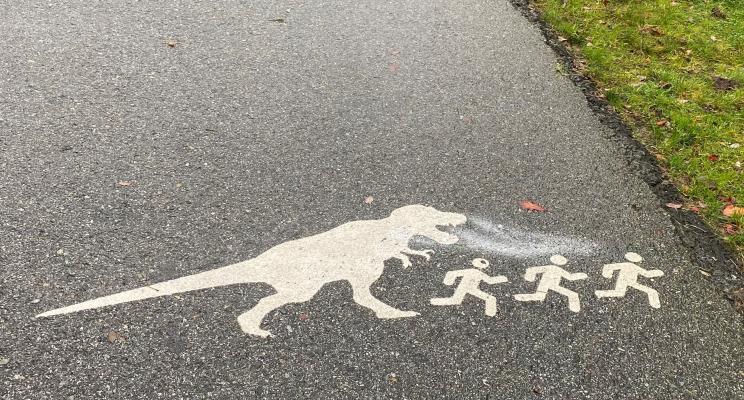The first one.... you barely notice. Just like any other mark identifying the path as designated for bikers, hikers, rollerbladers.Then.... hold on... wait a minute... uno dos... it's time to go.... backtracking and checking, resolving the cognitive dissonance between the expected and the seen.
A skateboarder... a Dog? on a skateboard?
And why is this person running? Wait - why are all these people running?
North Vancouver contains a series of connected anything-but-automobile paths of about 7.5 km long, which according to the City of North Van's site is referred to as the 'green necklace' - and has a long history.
Personally, I wish they had left the trees alone. A forest is much more beautiful and soul-restoring than a park. This need for control, this need for manicure, for design, that some of these garden-movements introduced, created an un-natural environment with natural elements in a straight jacket. Still - I'm glad we have as much green space as we do in North Vancouver.
From the City of North Vancouver's site:
The idea for the Green Necklace began over 100 years ago. Edward Mahon, who arrived in BC in 1890 and was a central figure in the North Vancouver Land and Improvement Company, pictured a "Grand Boulevard" encircling the new city. This idea was influenced by the Garden City and City Beautiful planning movements of the late 1800s – a response to the deteriorating conditions of industrial cities in Europe.
Mahon said:
"Completion of this great public way, with the supporting parks and gardens, will perpetuate health areas and pleasure grounds within a short distance of every resident of the present City of North Vancouver, and our municipality will have the distinction of possessing the most spacious boulevard contained within the limits of any city in the world – a great artificial lung, encompassing the central town, breathing, pressing, forcing into it health and vitality"
The City Beautiful Movement was a reform philosophy of North American architecture and urban planning that flourished during the 1890s and 1900s with the intent of introducing beautification and monumental grandeur in cities. It was a part of the progressive social reform movement in North America under the leadership of the upper-middle class concerned with poor living conditions in all major cities. [wikipedia]
The public art on the asphalt is by Mia Weinberg. She says "I developed a concept for artwork along the Green Necklace greenway in North Vancouver that combines a quality of whimsy and delight with a clear affirmation that the Green Necklace is a welcoming place for the entire community to enjoy." Mia’s public art projects are designed to resonate with the location where they will be placed. She explores connections between the natural environment and the places where we live, our personal memories, and our collective civic and cultural stories.


Add new comment